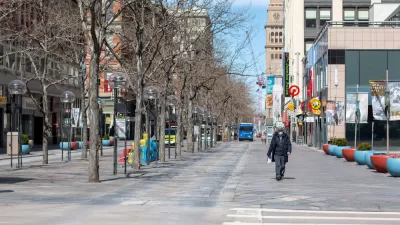Accounting for 45% of America's land mass and 30% of its population, the Great Plains, the Intermountain West, the Gulf states, and the Southeastern industrial belt are key to a national revival, says a new report from the Manhattan Institute.
Joel Kotkin summarizes a new report that he and his colleagues at the Manhattan Institute have published that points to the rising economic importance of four "growth corridors" in the United States: the Great Plains, the Intermountain West, the Third Coast (spanning the Gulf states from Texas to Florida), and the Southeastern industrial belt. "Historically," says Kotkin, "these regions were little more than resource colonies or low-wage labor sites for richer, more technically advanced areas. By promoting policies that encourage enterprise and spark economic growth, they're catching up."
"These regions have different histories and different trajectories into the future, but they share certain key drivers of economic growth: lower costs (particularly for housing); better business climates; and population growth. Some have benefited from the strong global market for commodities, particularly food, natural gas, and oil. Others are expanding because of a resurgence in manufacturing in the United States."
"To be sure, New York, Los Angeles, the San Francisco Bay Area, and Chicago will remain the country's leading metropolitan agglomerations for the foreseeable future," he acknowledges. "But an important urban story of the coming decades will be the emergence of interior metropolitan areas such as Houston, Dallas–Fort Worth, Tampa, Oklahoma City, and Omaha. On a smaller scale, fast-growing Lafayette (Louisiana), Baton Rouge, Midland (Texas), Sioux Falls (South Dakota), Fargo, and a host of other smaller cities will continue to expand. We may also witness the resurgence of New Orleans as a leading cultural and business center for the south and the Gulf Coast."
"The corridors' growing success is a testament to the resiliency and adaptability of the American economy," Kotkin concludes. "It also challenges the established coastal states and cities to reconsider their current high-tax, high-regulation climates if they would like to join the growth party."
FULL STORY: America's Growth Corridors: The Key to a National Revival - A New Report

Alabama: Trump Terminates Settlements for Black Communities Harmed By Raw Sewage
Trump deemed the landmark civil rights agreement “illegal DEI and environmental justice policy.”

Planetizen Federal Action Tracker
A weekly monitor of how Trump’s orders and actions are impacting planners and planning in America.

The 120 Year Old Tiny Home Villages That Sheltered San Francisco’s Earthquake Refugees
More than a century ago, San Francisco mobilized to house thousands of residents displaced by the 1906 earthquake. Could their strategy offer a model for the present?

Ken Jennings Launches Transit Web Series
The Jeopardy champ wants you to ride public transit.

BLM To Rescind Public Lands Rule
The change will downgrade conservation, once again putting federal land at risk for mining and other extractive uses.

Indy Neighborhood Group Builds Temporary Multi-Use Path
Community members, aided in part by funding from the city, repurposed a vehicle lane to create a protected bike and pedestrian path for the summer season.
Urban Design for Planners 1: Software Tools
This six-course series explores essential urban design concepts using open source software and equips planners with the tools they need to participate fully in the urban design process.
Planning for Universal Design
Learn the tools for implementing Universal Design in planning regulations.
Clanton & Associates, Inc.
Jessamine County Fiscal Court
Institute for Housing and Urban Development Studies (IHS)
City of Grandview
Harvard GSD Executive Education
Toledo-Lucas County Plan Commissions
Salt Lake City
NYU Wagner Graduate School of Public Service





























